Shopping for a thermal imager/camera for your Android smartphone?
You’ve come to the right place.
There are plenty of compact thermal imagers that are great for portability. But a smartphone thermal imager provides a whole new level of portability.
Because the imager doesn’t need to have a display (it uses your smartphone as the display), it can achieve a much more compact form factor compared to standalone thermal cameras.
There are some tradeoffs. For instance, many smartphone thermal cameras have a lower thermal resolution, with some going as low as 32 x 32. On the upside, these small imagers are pretty affordable, making them great for home owners, hobbyists and amateurs.
What’s In This Buying Guide?
In this buying guide, we recommend the best thermal imagers for Android smartphones. Keep in mind that these imagers work alongside a companion app, so you’ll have to download an app to use the imager.
Our top picks include the two most popular smartphone (iOS and Android) thermal imagers: FLIR One and
Seek Compact. If you are only interested in one of these two, read our
FLIR One vs. Seek Compact comparison.
Best Thermal Imagers for Android Phones
Seek Thermal Compact
Best overall
Connector:
USB-C/Micro-USB
Seek Thermal Compact
Best overall
Connector:
USB-C/Micro-USB
Seek Thermal CompactXR
Best for hunting and outdoors
Connector:
USB-C/Micro-USB
HT-301
Best for pros
Connector:
USB-C/Micro-USB
PerfectPrime IR0102
Best budget
Connector:
USB-C/Micro-USB
Seek Thermal CompactPRO
Best resolution
Connector:
USB-C/Micro-USB
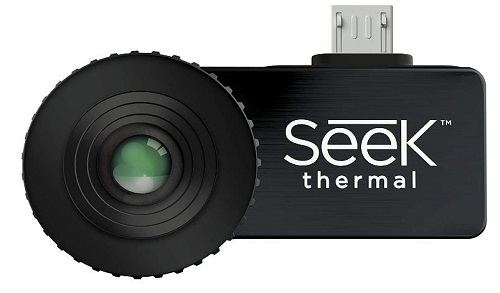
The Seek Thermal Compact combines high resolution, a wide temperature measurement range and plenty of in-app features in a well-priced package.
The Seek Thermal Compact is not just one of the best thermal imagers for Android smartphones; it is also one of the best value for money.
Pros
- Good value for money.
- Good thermal resolution.
- Both Micro USB and USB-C options available.
- Long detection distance and wide temperature range.
- Easy to use app with tons of features and options.
Cons
- Low frame rate – not ideal for moving targets.
- No calibration adjustment for emissivity.
- No visual and thermal image overlay like the FLIR ONE.
Our Review
It’s a tough pick between Seek Thermal Compact and FLIR ONE (specifically FLIR ONE Gen 3) for the best overall award.
We went with Seek Thermal because it provides better resolution, a wider temper range and more in-app features than FLIR ONE for about the same price.
You’ll get better value for your money with the Seek Thermal Compact.
The 206 x 156 thermal sensor is good enough for most basic applications. The images are clear and detailed and you can view surfaces from quite a distance (up to a 1,000 ft.), allowing you to examine hazardous or hard-to-reach areas without getting too close.
The sensor can detect temperatures between -40F and 626F, letting you monitor a wide variety of surfaces from a refrigerant system to a hot car engine.
The image contrast on the app is pretty good. Different colors show up well and you can even select different palettes to improve contrast and detail.
Other features available on the app include spot temperature measurement, Hi and Lo temperature mode and Threshold mode. You can also take thermal photos and videos – they’ll be stored in your phone.
The Seek Thermal Compact for Android is available in two options. One comes with the old Micro USB connector and the other has a USB-C connector for newer smartphones.
Seek Thermal Compact doesn’t have a battery nor does it need recharging. It powers itself from your phone’s battery. But don’t worry; most users say it doesn’t drain the phone batter quickly. In fact, many did not see a big difference in battery life.
Issues and Limitations
Because of its low refresh rate, moving objects might lag on your smartphone screen, making it harder to get a proper temperature reading.
Another issue is the lack of emissivity settings in the app, a big problem for users who want to maintain temperature precisions when measuring different types of surfaces. Only the Seek Thermal CompactPro has emissivity settings.
One area where FLIR one outmatches Seek Thermal is in image detail. FLIR ONE has a great feature that overlays visual and thermal images to give you more context when observing a surface.
If you’ve used a FLIR ONE smartphone thermal imager before, the overall image quality from Seek Thermal will be a slight downgrade.
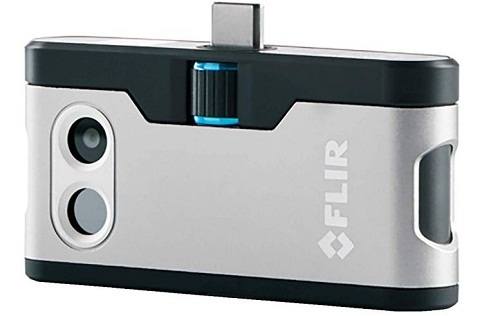
FLIR ONE’s cool MSX Image Enhancement feature is the main reason why we think the Gen 3 Android thermal imager is the best choice for home repairs.
It overlays a visual image with a thermal image, providinghelpful context and extra details especially in low lit areas.
The image overlay makes it easy to spot water leaks, diagnose your floor heating system and other home repairs.
Pros
- Image overlay makes it easier to spot problematic areas.
- Easy to use app with lots of features.
- Adjustable height connector fits phones with thick cases.
- Lightweight design.
- Emissivity settings.
Cons
- Battery drains fast.
- Low resolution.
- No thermal-only or visual-only image options.
Our Review
One common misconception is that the FLIR ONE imagers use your phone’s camera to take a normal picture and then overlay it with a thermal image from the imager’s sensor.
That’s half-true. The FLIR ONE Gen 3 does overlay a normal and thermal image, but it takes both images using its own built-in sensors. It has both a normal visual camera and a thermal camera. You can see them on the imager.
The image overlay feature – what FLIR calls MSX Image Enhancement –gives you a better idea of what you are seeing. If there’s a leak somewhere, the visual overlay makes it easier to spot exactly where it’s coming from.
The MSX feature mitigates the low contrast and reduces image quality of the low-resolution 80 × 60 sensor.
The FLIR ONE app is easy to use and comes with the usual features such as palette selection, spot temperature and video and image capture.
Unlike most other thermal imaging apps, the FLIR ONE app has emissivity setting. They are not precise like those of a professional standalone thermal imager. Instead, you select from various surface types including matte, semi-matte, semi-glossy and glossy.
As for the hardware, one of our favorite features of the FLIR ONE Gen 3 is the adjustable height USB-C connector. This allows you to connect the thermal imager without removing your phone case. Simply make the connector longer so that it insets fully into your phone’s port.
Another unique feature of the FLIR ONE Gen 3 is that it has an internal battery, which saves your phone’s battery from running out too quickly.
Issues and Limitations
Having an internal battery is both good and bad. On the upside, your phone’s battery lasts longer. On the downside, the imager’s internal battery runs out much sooner. The battery life is about 30 minutes.
This is okay for most applications. In most cases, you only check an area for a few minutes. But if you plan to use the imager for extended periods, you are better off with the Seek Thermal Compact.
Another issue with the FLIR ONE Gen 3 is the low resolution. Image overlay helps, but the 80 x 60 sensor significantly lowers image contrast and limits detection distance. You have to be close to get a clear image.
That’s why we recommend the FLIR ONE Gen 3 for home repairs. If you want better image contrast, more features (such as the ability to switch between MSX, thermal-only and visual-only images) and a wider temperature range, get the pricier FLIR ONE Pro.
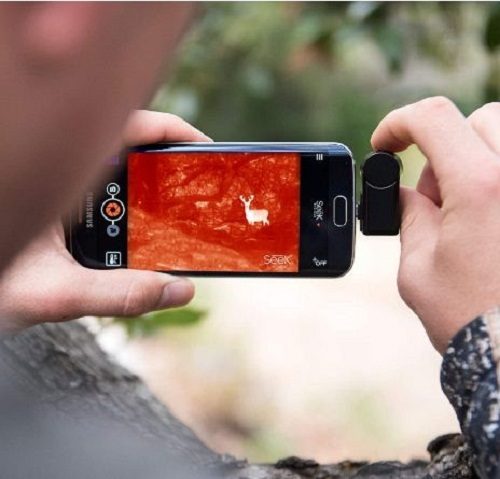
The CompactXR has the same resolution as the Seek Thermal Compact, but extends the detection distance to 1,800 feet or 600 yard.
This makes the Seek Thermal CompactXR imager perfect for outdoor application like hunting and home security.
Pros
- Long detection distance.
- Good resolution.
- Wide temperature range.
- Watertight carrying case.
- Dual image mode.
Cons
- Narrow field of view.
- Low refresh rate.
Our Review
The Seek Thermal CompactXR is designed specifically for long-range outdoor applications.
The thermal sensor can detect objects as far as 600 yards. You can look for animals through bushes (at night or during the day), fog, smoke and other obstructions.
The long range also makes CompactXR great for home security, whether you are watching out for human intruders or that coyote that’s been attacking your calves. You can also use the CompactXR to look for a lost pet.
Keep in mind that 600 yards is just the detection range. To positively identify a target, you’ll need to be much closer – between 100 and 200 yards depending on the size of the target.
The 206 x 156 thermal resolution produces a clear, high quality image even from a distance. You can see the outline of an animal or person and the contrast is good enough to easily differentiate between different temperatures.
The app is a bit unintuitive, but works smoothly without crashing or freezing. In-app features include palette selection, Hi-Lo temperature, spot temperature and video/image recording.
Another handy in-app feature is the ability to combine a normal image from your phone’s camera with the thermal image from the CompactXR. You may have to zoom the visual image to align it perfectly with the thermal image.
Unlike FLIR ONE’s MSX feature, you cannot save the overlay as a single image. The imager will save them as two images – a thermal image and a visual image.
This is still useful since the visual image can later help you tell what you were looking at when taking the thermal image.
Like the Compact thermal imager, CompactXR relies on your phone’s battery. You don’t have to worry about constantly recharging it.
Depending on your smartphone, you can order a CompactXR imager with a USB-C connector or a Micro-USB connector.
Issues and Limitations
The CompactXR’s field of view is just 20 degrees. That’s why we recommend it for long-range outdoor use. Do not use it for close-up inspections; you’ll only see a small area of the surface.
The small FOV is not a big problem when outdoors. 20 degrees translates into a larger view area the further out you look.
One limitation you’ll encounter is when observing moving targets such as an animal that’s on the run. The CompactXR has a low refresh rate (9 Hz) that can make moving targets lag on your phone’s screen.
For more money, you can get the Seek Thermal CompactPro. It has a higher resolution (320 x 240), the same long detection range and additional settings like emissivity control and Span and Level.
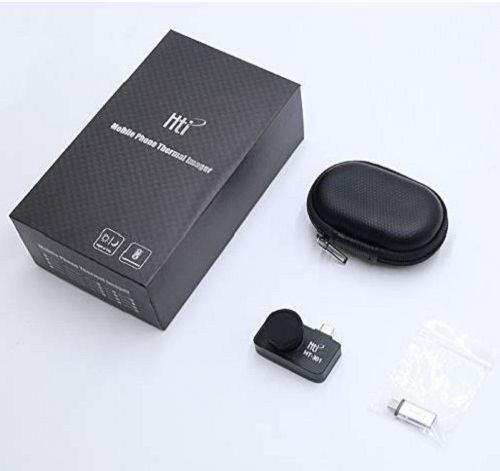
For professionals that love the convenience and portability of a smartphone thermal image, we recommend the Hti HT-301 thermal imaging camera.
The HT-301 has one of the highest resolutions and refresh rates you’ll find in a smartphone thermal camera.
Pros
- Great image quality.
- Excellent build quality – metal casing.
- Multiple temperature measurement modes.
- High refresh rate – great for observing moving targets.
- Thermal to visible image switch.
- Adjustable settings for emissivity, reflection, ambient temperature and others.
Cons
- Pricey
- The focuser is a bit loose.
- No image overlay like FLIR ONE.
Our Review
The Hti HT-301 is not a cheap thermal imager. It costs almost as much as standalone thermal cameras. But it’s worth the price tag.
Resolution, refresh rate, in-app settings and build quality are all some of the best among smartphone thermal imagers.
Let’s start with resolution. The 384 x 288 sensor is the same resolution you get with mid-range professional thermal cameras. The high resolution delivers a high quality, clear and high-contrast image.
Another advantage of the higher than average resolution is that you can view object from further out than you would with a lower resolution imager. For instance, you can take a thermal image of an entire building from a distance.
The long detection range is also great for outdoors, particularly hunting.
Coupled with the 25 Hz refresh rate (much higher than the 9 Hz in other smartphone imagers), hunters will love how easy it is to spot animals whether it’s at night, in thick bushes or though fog.
As for software, the HT-301 uses Hti Image as the companion Android app. The app is well designed and is easy to use.
But what stands out most in the app is the range of features and options. We are used to basic thermal imagers that offer a smattering of settings like multiple palettes and a couple of temperature modes.
The Hti Image app goes much deeper, giving pros access to a ton of helpful tools. These include six palettes, two temperature ranges, two temperature units and a picture-in-picture mode with a visual image from your camera and a thermal image from the HT-301.
Where things get interesting is the thermography settings menu. You can tweak six different settings including emissivity, humidity, distance, correction, reflection and ambient temperature.
This level of versatility allows pros to observe and measure different surfaces with precision.
Similar to other thermal imaging apps, you can record thermal videos and images, which are saved on your phone.
As for the hardware, the HT-301 camera is one of the best made smartphone thermal imagers around. From pictures, it looks like it’s made with plastic. The chassis is actually aluminum, which increases the hardiness and durability of the camera.
It includes a manual focuser and a USB-C connector. If your phone has the old Micro-USB port, a USB-C to Micro-USB adapter is included.
Note that the HT-301 camera lack an internal battery, which is actually a good thing. You don’t have to worry about recharging it and you can keep using the camera for longer.
From what users say, the HT-301 does not drain your phone’s battery any faster than usual.
Issues and Limitations
If you are shopping for a budget thermal imager for your Android phone, the HT-301 is not it. The HT-301 is a pricey thermal camera meant for pros and folks that want the best image quality.
For the price, we wish the HT-301 camera offered an image overlay feature like the one in FLIR ONE cameras. Many professional users say that’s the one feature they miss.
Overlaying a visual and thermal image, or even having them side by, would provide more detail and clearer reference and context especially when analyzing the images later.
Another complaint from pros is that the focusing mechanism that slides the lens in and out of the body is not very secure. It wobbles, making it harder to focus on something especially in close range.
5. Best Cheap Thermal Imager for Android Smartphones: PerfectPrime IR0102
Shopping on a budget? The PerfectPrime IR0102 is one of the cheapest thermal imagers for Android smartphones.
Image quality is so-so, but it’ll do for basic home repairs, ghost hunting and other fun uses. It’s also a great way to introduce older kids to thermal imaging.
Pros
- Affordable.
- Includes Micro-USB adapter.
- Easy to use app.
- Live visual and thermal overlay.
- Multiple palettes to choose from.
Cons
- Very low resolution.
- Only ideal for very basic or fun applications.
Our Review
Check your expectations when it comes to the IR0102’s image quality. It has a resolution of 32 x 32, the lowest we’ve seen in any smartphone thermal camera.
You’ll get a small image at the center of your smartphone screen showing various colorsfor different temperatures.
You have to be very close to the surface or area you are examining to get a decent image. And even then, it appears blurry and the contrast between different colors is not very sharp.
That’s not to say that you shouldn’t buy the PerfectPrime IR0102. For basic application like looking for a water leak, it’ll do. It’s also a great choice if you want a thermal camera just for fun. It also makes for a great educational tool for older kids.
The companion Android app (IR0102 Thermal Camera Viewer) is simple and easy to use. As expected, in-app features are basic. You can select different palettes, change temperature units and read center or point temperature measurements.
Surprisingly, the IR0102 has a FLIR-like image overlay feature. It’s not quite as refined, partly because of the poor resolution and the fact that the imager relies on your phone’s camera for the visual image, which causes alignment issues.
You can view a visual-only photo, a thermal-only photo or a blend with 50% visual and 50% thermal.
Despite the low resolution, the IR0102 imager can be actually useful if you know how to use it. The trick is to get as close as possible to the surface, select the right palette and learn how to use both the visual and thermal images to examine a surface.
The app has an additional setting called dynamic range that somewhat compensates for the low resolution and contrast. Increasing dynamic range makes various colors stand out better, and makes it easier to tell which areas are hot or cold.
The PerfectPrime IR0102 comes with a USB-C connector. You’ll also get a USB-C to Micro-USB converter if your phone has a Micro-USB port.
Issues and Limitations
We’ve talked plenty about where the Perfect Prime IR0102 falls short – it has low resolution, image quality is below average and the app is bare-bones when it comes to features.
But keep in mind that the Perfect Prime IR0102 is designed to be a cheap thermal imager for basic applications or for those who just want to have fun with a thermal camera without spending a lot of money.
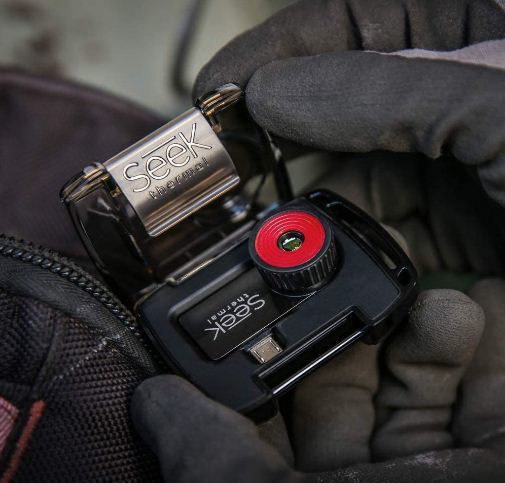
This is the third Seek Thermal imager among our picks (they are that good) and the best of the Seek Thermal Compact series.
The Compact is great for amateurs, DIYers and homeowners while the CompactXR is great for outdoors and hunting.
The CompactPRO is the best choice for those who want a high-resolution smartphone thermal imager that’s still affordable. The 320 x 240 thermal sensor produces stunning thermal images with great contrast and a long detection distance.
Pros
- Great image quality.
- Emissivity control.
- Long detection distance – great for outdoor applications.
- Easy to use app with lots of features and options.
- Focusable lens.
Cons
- Cost more than most other smartphone thermal imagers.
- Low refresh rate.
- Doesn’t work with thick phone cases.
Our Review
The 320 x 240 resolution is pretty good for a smartphone thermal imager. It comes close to what you get from mid-range standalone thermal cameras.
Colors show up clearly on your phone’s screen and it’s easy to see the different temperatures. Temperature measurement options include spot temperature, Hi/Lo temperatures and Threshold mode.
The app also includes emissivity settings, allowing you to maintain precision when measuring the temperature of different surfaces.
You also get both auto and manual Span/Level Control, which helps you better isolate the problem area for easier diagnosis.
Other features include multiple color palettes, photo and video recording and a decent 32-degree field of view.
Looking at all these features, the CompactPRO is actually a great choice for pros looking for something pocket-friendlier than the HT-301. It’s also great for home repairs, car maintenance and DIY projects.
Outdoor enthusiasts and hunters will also love the CompactPRO’s 1,800ft detection range. You can spot an animal or intruder from afar.
The CompactPRO is available in two versions: one with a USB-C connector and another with a traditional Micro-USB connector. Each unit comes with a waterproof carrying case.
As for power, the CompactPRO draws power from your phone’s battery. But it’s not a hog, so you don’t have to worry about your phone draining too quickly.
Issues and Limitations
While not as expensive as the HT-301, the CompactPRO costs more than other thermal imagers in our picks. If your budget is tight, consider the other Seek Thermal cameras – either the Compact or CompactXR.
One thing to note if you are planning to use the CompactPRO outdoors is that the refresh rate is low. At 9 Hz, you’ll have problems observing a moving target like a running animal.
Another issue is that the CompactPRO has trouble connecting to a phone that has a thick case on. This is a problem if you are planning to use the imager in rough environments where your phone could fall and get damaged. An adjustable-height connector like that of the FLIR ONE Gen 3 would have been great.
What is a Smartphone Thermal Imager?
A smartphone thermal imager is a small compact thermal camera that attaches to your phone’s USB port.
Unlike standalone thermal cameras that have their own display, a smartphone thermal imager uses your phone’s display as its interface via a companion app. Most smartphone thermal imagers also run off your phone’s battery.
The lack of an internal battery and an integrated screen allows smartphone thermal imagers to be really small, and much cheaper than conventional thermal cameras.
Pros and Cons of Smartphone Thermal Imagers
Pros
- Highly portable. Most smartphone thermal imagers are small enough to fit in your pocket.
- Cheaper than conventional thermal imagers.
- No internal battery (for most), meaning no need to keep recharging the camera.
- A smartphone app provides a bigger and easier to use interface compared to the small displays on conventional thermal imagers.
Cons
- Most have lower resolution compared to standalone thermal cameras.
- Fewer features. For instance, most don’t provide emissivity controls.
Buying Guide: How to Select the Right Thermal Imager for Your Android Phone
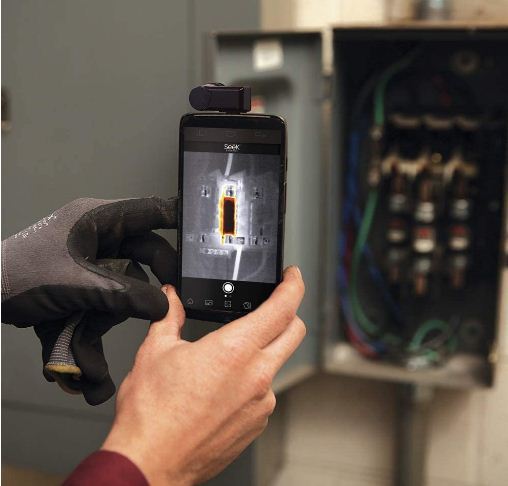
Here are the key features to consider when choosing a thermal imager for your smartphone.
Resolution and Refresh Rate
The first thing to check when buying a thermal imager, whether a smartphone or standalone imager, is resolution.
Resolution tells you a lot about the image quality you can expect. Typically, smartphone thermal imagers don’t have a resolution as high as professional thermal imagers. The best you’ll get is 384 x 288 or 320 x 240.
At this resolution, you’ll get high quality images with good contrast and detail. You’ll also enjoy a longer detection distance, allowing you to look at objects that are far away.
As resolution goes down, so does image quality, contrast, level of detail and detection distance.
For basic home repairs, you can do with a cheaper lower-resolution smartphone thermal imager. But if you need detailed and highly accurate thermal imagers, spend more on a high-resolution sensor.
Refresh Rate
Another related feature is refresh rate or frame rate. This is important if you plan to observe a moving target such as when hunting.
Most smartphone imagers have a 9 Hz frame rate, which is very low compared to conventional thermal cameras. But since you’ll often be looking at static objects and surface, this is not a big problem.
But if you plan to go hunting, get an imager with a higher frame rate of at least 25 Hz.
Temperature Range
You likely won’t need to worry about this one. Most smartphone thermal imagers have sufficient temperature range for a wide range of applications.
But just in case you plan to look at some extra-cold or extra-hot surfaces, it’s important to check that the temperature range meets your needs. For instance, the FLIR ONE Gen 3’s range is 4°F to 248°F while all Seek Thermal’s cameras have a range of -40°F to 626°F.
Field of View (FOV)
The bigger the FOV, the wider a surface you can observe without moving your phone. A wide FOV of at least 30 degrees is good enough for most applications.
For long-range applications like hunting, you can do with a narrower FOV since it translates into a wide viewing area at a long distance. For instance, the Seek Thermal CompactXRhas a 20-degree FOV and is perfect for hunting.
Compatibility
Before you buy a thermal imager, check manufacturer specs for phone compatibility. This includes band (e.g. Samsung, Huawei etc.), earliest model (e.g. Samsung S6 and later) and software version (e.g. Android 6 and later).
App
Finally, check the companion Android app. Two things to look for here include ease of use (look for reports of bugs and crashes from users) and features.
Basic features to expect include color pallets, at least two temperature modes and video/image recording. Additional features available in some thermal imaging apps include
- Image overlay – the app blends a visual and thermal image to provide more detail and context.
- Emissivity controls – the ability to adjust emissivity is crucial for professionals.
- Manual span and level – makes it easier to highlight the problem area.
FAQs

What are the best uses for a smartphone thermal imager?
Most smartphone thermal imagers are great for use around the home checking for water leaks, insulation, electrical wiring and other common problems.
High-resolution smartphone thermal imagers are also great for outdoor use such as hunting and home security.
Can you use a smartphone thermal imager to measure skin temperature?
NO. Smartphone thermal imagers are not designed to measure human temperature and using them for that can lead to inaccurate measurements.
In connection to that, a smartphone thermal imager is not ideal for Covid-19 protection. Get an approved infrared gun instead.
How accurate are thermal imagers for smartphones?
Accurate enough for most home and hobbyist applications.But compared to standalone imagers, smartphone thermal imagers are usually a few degrees off.
Can I use my phone as a thermal camera?
Yes, but only if you attach an external thermal camera. Your phone’s native camera only takes visual images; it cannot capture thermal images. That’s why you need an external thermal camera.
Some apps purport to provide thermal imaging using your phone’s camera, but they apply a filter to turn a normal image into one that look like a thermal image. These apps cannot detect heat on a surface.
What is the best thermal camera app?
You cannot go wrong with Seek Thermal. Pair it with one of the Seek Thermal cameras (Compact, CompactXR or CompactPro) to view real thermal images.
Another good option is FLIR ONE. You can pair the app with FLIR ONE Gen 3, FLIR ONE Pro LT or FLIR ONE Pro.